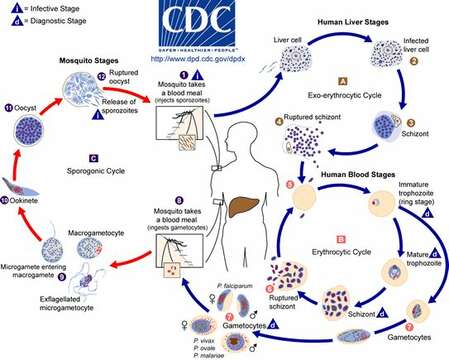Life cycle of plasmodium parasites causing malaria in humans

Description :
Life cycle of plasmodium parasites causing malaria in humans
The malaria parasite life cycle involves two hosts. During a blood meal, a plasmodium-infected female Anopheles mosquito inoculates sporozoites into the human host (1). Sporozoites infect liver cells (2) and mature into schizonts (3), which rupture and release merozoites (4). (Note that in P. vivax and P. ovale, a dormant stage [hypnozoite] can persist in the liver and cause relapses by invading the bloodstream weeks, or even years, later.) After this initial replication in the liver, a process known as exo-erythrocytic schizogony (A), the parasites undergo asexual multiplication in the erythrocytes (red blood cells), a process known as erythrocytic schizogony (B). Merozoites infect red blood cells (5). The ring stage trophozoites mature into schizonts, which rupture and release merozoites (6). Some parasites differentiate into sexual erythrocytic stages (gametocytes) (7). Blood stage parasites are responsible for the clinical manifestations of the disease.
The gametocytes, both male (microgametocytes) and female (macrogametocytes), are ingested by an Anopheles mosquito during a blood meal (8). The parasites’ multiplication in the mosquito is known as the sporogonic cycle (C). While in the mosquito's stomach, the haploid microgametes penetrate the haploid macrogametes, generating diploid zygotes (9). The zygotes in turn become motile and elongated stages known as ookinetes (10), which invade the midgut wall of the mosquito, where they develop into oocysts (11). The oocysts grow, rupture, and release sporozoites (12), which make their way to the mosquito's salivary glands. Inoculation of the sporozoites into a new human host perpetuates the malaria life cycle (1).
From Centers for Disease Control Parasites and Health website.
Inclus dans les pages suivantes :
- Life
- Cellular (Organismes cellulaires)
- Eukaryota (eucaryotes)
- SAR (Stramenopiles, Alveolates, Rhizaria)
- Alveolata
- Apicomplexa
- Aconoidasida
- Haemosporida
- Plasmodiidae
- Plasmodium
- Plasmodium knowlesi
Cette image ne figure dans aucune collection.
Informations sur la provenance
- licence
- cc-by-nc
- droit d’auteur
- Centers for Disease Control/Division of Parasitic Diseases and Malaria
- éditeur de publication
- Shapiro, Leo
- photographe
- Centers for Disease Control/Division of Parasitic Diseases and Malaria
- fournisseur
- EOL Rapid Response Team
- original
- fichier de média d’origine
- visiter la source
- site partenaire
- EOL staff
- ID


